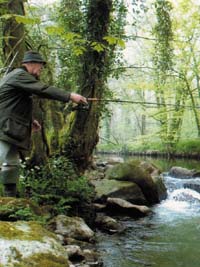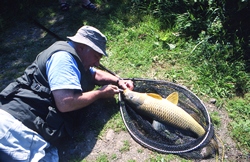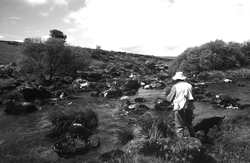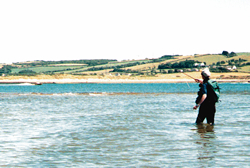Game Fishing in the South West
Wild brown trout on the moors, spring salmon in north Devon, sophisticated trout on the chalkstreams, big rainbows on famous reservoirs, night expeditions for sea trout, winter salmon in Cornwall - these are just a few of the pleasures awaiting the game fisherman in south west England.
And it is a long season too. Salmon are in season somewhere in the south west from February to 15 December, leaving a close season of little more than six weeks in the dead of winter. River fishing for trout or sea trout is available from mid March to mid October, and the growth of winter rainbow fisheries means that you can cast a fly to trout every month of the year.
SALMON
For the visiting angler, the best opportunities for salmon are on the rivers of Devon, west Somerset and, especially late in the season, Cornwall.
In the past few years, the best spring salmon fishing has been on the Taw, which produced around 250 springers in 1996, with the Torridge also offering improved early fishing. Spring is traditionally the time for spinning but the fly-only restriction on these rivers from I May, which has been in place for many years, has given anglers greater confidence in the fly, which is now in increasing use right from opening day on 1 March. North Devon's other salmon river, the East Lyn, is a prolific little fishery and can produce very good fishing immediately after floods at any time in the season, though here all of the salmon fishing is with worm or spinner.
On most salmon rivers in the south west the best of the fishing is in summer and autumn, especially when there is sufficient rain to bring in good runs of grilse. At such times good fishing will be found on the Tamar, Dart, Teign, Taw, Torridge and others. The Exe, in particular, can produce excellent catches of grilse in late summer and a recent survey indicated that angling success rates on this river were the highest for salmon in England and Wales.
Although the Cornish rivers also produce summer salmon fishing, the Camel and Fowey are noted for their autumn and winter fishing, with salmon fishing continuing until 15 December.
In the east of the region, there is also salmon fishing on the Frome and Avon, though here it is less easy for the visiting angler to get a salmon permit.
SEA TROUT
Night fishing for sea trout is a real south west speciality, and especially on the Devon rivers. Around the end of April the early big sea trout have arrived in sufficient numbers for serious night expeditions by the keener anglers and numbers continue to grow right through to late summer. As the season progresses the average weight drops, especially with the arrival of the summer school peal which are often less than a pound.
If you are looking for a really big sea trout there are few better places than the lower Dart early in the season, where fish in excess of 10lb are caught in most seasons and sea trout of 61b to 81b are relatively common. With the exception of the Ex., the main rivers of the south west all offer plenty of opportunities for a night's sea trout fishing.
TROUT
The river trout angler can choose between the silky chalk streams of Wessex and the turbulent moorland rivers of the far south west, with many variations between these two extremes. The chalk streams of the West Country may not have the international fame of the Test and Itchen to the east, yet still they provide outstanding dry fly and nymph fishing for high quality browns, and the price of a day's fishing is much more affordable. Look out for fishing on the upper Wiltshire Avon and its tributaries, or fisheries on the Frome and Piddle in Dorset.
If you are looking for wild trout in beautiful surroundings, without size being the main criterion, the bubbling streams of the Dartmoor and Exmoor National Park offer endless opportunities. The trout may be of modest size but they are numerous and often free rising. Rivers like the upper Dart, Teign, East Lyn and Barle all offer plenty of day-ticket waters at reasonable prices.
Elsewhere there are plenty more opportunities for river trouting in the south west. Something similar to chalk stream fishing can be found on the little limestone rivers of the southernmost Cotswolds, and on the meadow streams of east Devon like the Otter. It is also worth searching out little-known streams like the Bray, upper Tone, Thrushell, Ottery, Yeo and many others that can produce surprisingly good trout fishing.
The development of trout fishing on water supply reservoirs in recent decades has been well documented, but it is often overlooked that this movement really got started at Blagdon Lake in Somerset back in 1904, producing browns and rainbows of sizes that most anglers had only dreamed of before. And it was Bristol Waterworks that boosted reservoir trout fishing again with the 1957 opening of Chew Valley Lake, only three miles from Blagdon Lake. Fortunately we can still enjoy the excellent trout fishing on both of these great lakes beneath the Mendip Hills, with the addition of many more trout lakes throughout the region. Shore fishing is available on all of these reservoirs and the larger lakes offer excellent loch-style boat fishing.
More recently the growth of small-purpose-built trout pools has exploded in the south west and there can be few fly fishers who are now more than a few miles from a trout fishery. All of the usual lake techniques and flies can be used on these lakes but it is worth looking out for those which are clear enough to enjoy the exciting sport of stalking big rainbows with a weighted nymph.
TACKLE
For salmon you will need equipment for both spinning and fly fishing, the latter being particularly important on the Taw and Torridge where fly only is the rule for most of the season. A spinning rod of 9ft and medium power is about right on most rivers, and with a fixed-spool reel and 12lb to 14lb line it will also handle worm or prawn fishing where bait is permitted. In spite of its name, few anglers in the south west now use the Devon minnow, most putting more faith in the Flying C, Mepps or Rapala.
Although the more open stretches on the larger rivers are suitable for a doublehanded salmon fly rod, many anglers stick to a powerful single-handed rod of 9ft or 10ft with lines of AFTM 7 to 9 and this could easily double up as a reservoir rod. For sea trout, however, such a rod might be a bit powerful and a 9ft rod and a 6 line would be more suitable. Popular salmon flies include Willy Gunn, Ally's Shrimp and Blue Charm, while sea trout anglers favour Alexander, Silver Stoat and Mallard and Claret.
Trout fly rods are as varied as the West Country rivers. On a small overgrown river where the branches meet over the middle of the stream, a 7ft fly rod and 4 line are ideal, but when you are fishing from the bank on a larger chalk stream a rod of 8+ft or even 9ft with a 5 line will help you to keep control when reaching over bankside vegetation. If you have to compromise with one outfit, try an 8ft rod and 5 line.
Bank fishing on the larger reservoirs will demand a powerful rod of 9ft and an 8 line, but on the smaller pools I often stalk big trout with an 8ft river rod and a 5 line, so there is no easy compromise if you wish to fish all the stillwater options in the south west - even before you consider the specialist needs of loch style fishing from a boat.
Any of the vast range of popular trout flies is worth a try, but on the rivers it is always worth remembering that patterns created long ago in the West Country, like Blue Upright, Pheasant Tail, Half Stone, Tup's Indispensable, Infallible and Devonshire Doctor, still perform very effectively.
SOMETHING FOR ALL
Whatever your taste in game fishing there is something for you in the south west - just check the list of places to fish in this guide. The visitor will find a wide range of day permits from hotels, associations and fishery owners, at an equally wide range of prices. The local angler should always consider joining an association, which is often the cheapest way of fishing, especially for salmon. Some of these clubs have open membership while others will have a membership limit and a waiting list, so check with the secretaries for details. But always remember that before you go fishing you need two pieces of paper - the Environment Agency national licence and a permit from the owner of the fishery.


 When I started fishing over half a century ago, carp had an almost mythical quality. Carp fisheries were few and far between – and when you found them their inhabitants had a reputation for being almost impossible to catch.
When I started fishing over half a century ago, carp had an almost mythical quality. Carp fisheries were few and far between – and when you found them their inhabitants had a reputation for being almost impossible to catch. The River Camel rises on Bodmin Moor and reaches the sea about thirty miles later at Padstow on the North Cornwall coast. The Camel has been fished for salmon and sea trout for centuries and the first royal charter was granted in1199. Records show that in 1750 rights were available on payment of a fee to the Duke of Cornwall to take salmon by use of barbed spears. Needless to say, these rights have now been revoked.
The River Camel rises on Bodmin Moor and reaches the sea about thirty miles later at Padstow on the North Cornwall coast. The Camel has been fished for salmon and sea trout for centuries and the first royal charter was granted in1199. Records show that in 1750 rights were available on payment of a fee to the Duke of Cornwall to take salmon by use of barbed spears. Needless to say, these rights have now been revoked.
 From the tumbling rivers of the high moors to the silky chalk streams of Wessex, the South West has something for just about every fly fisher who likes to go in search of brown trout in running water. You can drift a tiny dry fly over a rising brownie, work a team of traditional wet flies through a stretch of fast broken water, or explore the depths of a deep pool with a heavily-weighted nymph - the choice is yours. As this Guide clearly demonstrates, plenty of this fishing is available to the visiting angler who buys a permit from an association, hotel or fishery owner, but making the right choice is the key to success. So let's take a look at a selection of trout fisheries that regularly produce good fishing for anyone prepared to take the time to learn their secrets.
From the tumbling rivers of the high moors to the silky chalk streams of Wessex, the South West has something for just about every fly fisher who likes to go in search of brown trout in running water. You can drift a tiny dry fly over a rising brownie, work a team of traditional wet flies through a stretch of fast broken water, or explore the depths of a deep pool with a heavily-weighted nymph - the choice is yours. As this Guide clearly demonstrates, plenty of this fishing is available to the visiting angler who buys a permit from an association, hotel or fishery owner, but making the right choice is the key to success. So let's take a look at a selection of trout fisheries that regularly produce good fishing for anyone prepared to take the time to learn their secrets. I have been lucky enough to turn fishing into a career. Each week I can be found on river banks, messing around in boats and gazing over wide expanses of lake. Most of the time I’m teaching, but every week I manage a trip of my own. Lately, there have been some changes. Instead of heading for those venues described above I now make for the sea shore armed with neither a Beach Caster or Spinning Kit. My chosen weapon is the fly rod and the quarry are non-other than “Dicentrachus labrax” although I prefer to stick to their common name, Bass. Around two years ago my good friend Simon Gawesworth first introduced me to this exciting new branch of the sport. Having caught so many stocked Trout it was a revelation to catch such a wild, hard fighting fish in unusual surroundings. Abroad Saltwater Fly Fishing is nothing new but believe me over here it does attract the odd puzzled glance! Bass can be found in warm water areas of the British Isles, and are widespread along the South Coast.
I have been lucky enough to turn fishing into a career. Each week I can be found on river banks, messing around in boats and gazing over wide expanses of lake. Most of the time I’m teaching, but every week I manage a trip of my own. Lately, there have been some changes. Instead of heading for those venues described above I now make for the sea shore armed with neither a Beach Caster or Spinning Kit. My chosen weapon is the fly rod and the quarry are non-other than “Dicentrachus labrax” although I prefer to stick to their common name, Bass. Around two years ago my good friend Simon Gawesworth first introduced me to this exciting new branch of the sport. Having caught so many stocked Trout it was a revelation to catch such a wild, hard fighting fish in unusual surroundings. Abroad Saltwater Fly Fishing is nothing new but believe me over here it does attract the odd puzzled glance! Bass can be found in warm water areas of the British Isles, and are widespread along the South Coast.